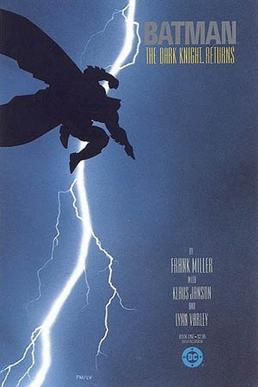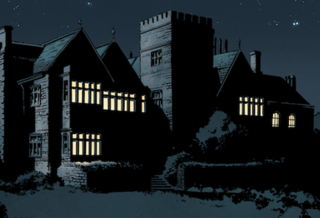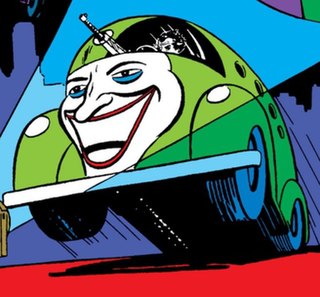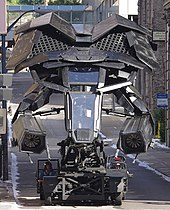
The Dark Knight Returns is a 1986 four-issue comic book miniseries starring Batman, written by Frank Miller, illustrated by Miller and Klaus Janson, with color by Lynn Varley, and published by DC Comics. It tells an alternative story of Bruce Wayne, who at 55 years old returns from retirement to fight crime while facing opposition from the Gotham City police force and the United States government. The story also features the return of classic foes Two-Face and the Joker, and culminates with a confrontation with Superman, who is now a pawn of the government.

The Elizabeth Arkham Asylum for the Criminally Insane, commonly referred to as Arkham Asylum, is a fictional psychiatric hospital/prison, named after the city of Arkham which appeared first in the stories of H. P. Lovecraft, and later appearing in American comic books published by DC Comics, commonly in stories featuring the superhero Batman. It first appeared in Batman #258, written by Dennis O'Neil with art by Irv Novick. The asylum serves as a (forensic) psychiatric hospital for the Gotham City area, housing patients who are criminally insane, as well as select prisoners with unusual medical requirements that are beyond a conventional prison's ability to accommodate. Its high-profile patients are often members of Batman's rogues gallery.

The Batcave is a subterranean location appearing in American comic books published by DC Comics. It is the headquarters of the superhero Batman, whose secret identity is Bruce Wayne and his partners, consisting of caves beneath his personal residence, Wayne Manor.

The Batmobile is the fictional car driven by the superhero Batman. Housed in the Batcave, which it accesses through a hidden entrance, the Batmobile is both a heavily armored tactical assault vehicle and a personalized custom-built pursuit and capture vehicle that is used by Batman in his fight against crime. Using the latest civilian performance technology, coupled with prototype military-grade hardware—most of which was developed by Wayne Enterprises—Batman creates an imposing hybrid monster car to prowl the streets of Gotham City.

Wayne Manor Estate is a fictional mansion appearing in American comic books published by DC Comics. It is the personal residence of Bruce Wayne, Owner of the Wayne Enterprises who is also the superhero Batman.

Hush is a supervillain appearing in American comic books published by DC Comics. Created by Jeph Loeb and Jim Lee, the character first appeared in Batman #609 in January 2003 as part of the twelve-issue storyline Batman: Hush. Hush serves as a criminal foil to the superhero Batman and belongs to the collective of adversaries that make up his rogues gallery.

Wayne Enterprises, Inc., also known as WayneCorp and Wayne Industries, is a wealthy fictional company appearing in American comic books published by DC Comics, commonly in association with the superhero Batman. Wayne Enterprises is a large, growing multinational company.

A batarang is a roughly bat-shaped throwing weapon used by the DC Comics superhero Batman. The name is a portmanteau of bat and boomerang, and was originally spelled baterang. Although they are named after boomerangs, batarangs have become more like shuriken in recent interpretations. They have since become a staple of Batman's arsenal, appearing in every major Batman television and film adaptation to date. Recent interpretations of the Dark Knight find additional motivation to use the batarang as a ranged attack and is used primarily to knock guns out of an assailant's hand. They also serve as Batman's calling cards to alert criminal elements of his presence and props to create an illusion to the superstitious that he commands bats when he throws them.
Lego Batman is a discontinued theme and product range of the Lego building toy, introduced in 2006, based on the superhero character Batman, under license from DC Comics. The sets feature vehicles, characters and scenes from the comics and films. The inspirations for the design of these vary widely. For example, the Batmobile retains its basic sleek shape and prominent fins from the Tim Burton films, whereas the "Bat-Tank" seems to be based on the tank-like Batmobile in Frank Miller's The Dark Knight Returns. The theme was relaunched in early 2012 as part of the Lego DC Universe Superheroes line, which is a sub-theme of the Lego Super Heroes line. In total there were 17 sets, almost all of them including Batman.

The Batcopter is the fictional personal helicopter of the DC Comics superhero Batman.

The Batcycle, Batblade, or Batpod is the fictional personal motorcycle of the DC Comics superhero Batman. In the comic book universe, Batman's personal Batcycle is a modified street-bike with a 786 cc liquid-cooled V-4 engine. It contains a computer-controlled carburetor and bulletproof wind-guard.

The Batboat, Batstrike, or Batsub is the fictional personal aqua-dynamic hydrofoil/submersible watercraft of the DC Comics superhero Batman.
The Imaginext System is a brand of role-playing, adventure toys designed for kids 3 or older made by Mattel, under the label of Fisher-Price.
Originally created in 1967, the fictional comic book character Barbara Gordon has been adapted into various other forms of media. The character has appeared in both live action and animated television series and films, as well as in video games in her alter-egos as both Batgirl and Oracle.
Amusement rides and stunt shows themed to the Batman franchise its derivative elements are commonly found at Warner Bros. and Six Flags amusement parks across the world.

The Joker, a supervillain in DC Comics and archenemy of the superhero Batman, has appeared in various media. WorldCat records over 250 productions featuring the Joker as a subject, including films, television series, books, and video games. Live-action films featuring the character are typically the most successful.

Batman of Zur-En-Arrh is a character appearing in media published by DC Comics. Introduced in the Silver Age, the character is an alien named Tlano from the planet Zur-En-Arrh who decided to become a version of Batman for his own planet. The character's reappearance in the 2000s rebranded him as a violent and unhinged backup personality of Batman; however, the alien version has been revealed to still exist in the main continuity.

The fictional supervillain Penguin, created by Bob Kane and Bill Finger, made his first appearance in Detective Comics #58. Since then, he has been adapted into other forms of media, including feature films, television series, and video games.

The Lego Batman Movie is a discontinued product line based on The Lego Batman Movie, the second film of The Lego Movie franchise. It is licensed from The Lego Group, DC Comics and Warner Bros. Animation. The theme was first introduced in 2017 as part of a licensing and merchandising programme associated with the film. Alongside the release of the Lego sets, the programme included the release of several promotional short films and The Lego Batman Movie Game app. The product line was discontinued by the end of 2018.

The Jokermobile is a specially designed automobile used by DC Comics supervillain Joker. The Jokermobile debuted in Batman #37, and was created by Jerry Robinson.



















